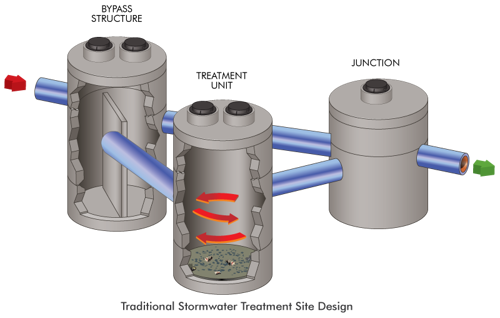
Don’t Bypass Good Design Part 1: Offline Vs. Online Diversion Structures
Months of design, pages of specifications, and tens or even hundreds of thousands of dollars may go into the design of a single bioswale, filtration basin, or other stormwater treatment system. So why do we spend so little time thinking about the flow control devices that make them work? This article is part one of a two-part series on bypass design and focuses on external diversion structures as compared to treatment units with internal bypass capability.
It is impractical to treat an entire large storm event, so we design for the “first flush”, the initial runoff where we expect most pollutants to be conveyed. However, in big storms we want our infrastructure to efficiently convey runoff downstream without negatively impacting treatment devices. To achieve this balance, we rely on a type of device called a diversion or bypass system.
Traditionally, a bypass structure with a weir is placed upstream of an offline treatment unit. A smaller low-flow pipe transfers influent to be treated and reconnects the effluent to the mainline piping downstream. Often, a junction or return manhole is needed to join these pipes, resulting in a total of three structures.

In contrast, some online proprietary treatment devices are outfitted with an internal weir. These devices treat low flows, bypass peak flows, and discharge both through a single outlet. This innovation reduces the complexity of storm sewer layout and significantly reduces cost as the contractor can install one manhole instead of three. There are additional benefits of online units. They are ideal for retrofit applications where an existing drainage line, standard junction manhole or poorly performing device can be replaced without other site disturbance. There are also quality control advantages to having the weir integral to the treatment system’s internal components. In particular, the device would come with the weir set to the correct height with no opportunity for error by the specifier or installer.
However, I would caution engineers to be careful when designing online units. Does the flow path in the unit route high-velocity bypass away from sensitive filter surfaces and from previously captured pollutants? Do these pollutants stay contained or are they subject to scour from increased turbulence? Does the unit have adequate internal bypass capacity to convey the design peak storm event?
Even with a well-designed online unit, a designer might choose to place a treatment device offline for other reasons. In general, for very high flow rates an external bypass structure will scale better than trying to upsize a treatment structure. Likewise, the weir crest length in a bypass structure is typically longer than in an online treatment system. As a result, this reduces head losses associated with bypassing a particular flow rate and is beneficial on sites with hydraulic limitations.
External bypass structures are also more flexible in their configurations. For example, a bypass vault’s dimensions could be altered to accommodate a large pipe or odd pipe entry angle. In contrast, online systems are often constrained by the restrictions of the devices’ internal components which limit the number or locations of inlet pipes. Finally, external bypass structures can accommodate additional special features, like orifice plates and adjustable weirs. Not every project requires such appurtenances, but it is always nice to have options.
In the next blog post, I will look at the different types of flow control devices used for bypass. I will dig into the specifics of hydraulic head versus discharge and weigh the pros and cons of different approaches.
